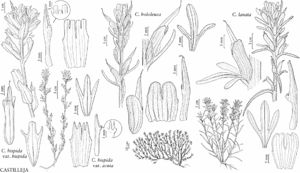Castilleja hispida var. hispida
Leaves linear or lanceolate to narrowly oblong or ovate, (0–)3–5(–7)-lobed, apex rounded to acute. Bracts distally red of various shades or yellow, sometimes orange or burnt orange, older bracts sometimes aging orange to yellow on plants with red bracts; lobes linear to oblong, medium length, apex rounded, sometimes truncate or acute. Calyces 12–35 mm; lateral clefts 2–7 mm; lobes oblong to lanceolate, apex obtuse to rounded. Corollas 17–38 mm; abaxial lip 0.5–1.5 mm, to 10–20% length of beak. 2n = 24, 48.
Phenology: Flowering (Mar–)Apr–Aug.
Habitat: Grassy or rocky slopes, coastal bluffs, dry prairies or open forests, valleys, montane, occasionally to subalpine.
Elevation: 0–2100 m.
Distribution
Alta., B.C., Idaho, Mont., Oreg., Wash.
Discussion
Variety hispida is fairly common in the lowlands and islands of western Washington, northwestern Oregon, and southwestern British Columbia, and it extends into the montane and subalpine zones of the Cascade Range and Olympic Mountains. It also ranges eastward sporadically on both sides of the United States-Canada border to northwestern Montana and adjacent southern Alberta. Variety hispida forms occasional hybrids with Castilleja levisecta in Thurston County, Washington, and with C. chambersii in Clatsop County, Oregon.
Selected References
None.
